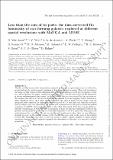Less than the sum of its parts : the dust-corrected Hα luminosity of star-forming galaxies explored at different spatial resolutions with MaNGA and MUSE
Abstract
The Hα and Hβ emission line luminosities measured in a single integrated spectrum are affected in non-trivial ways by point-to-point variations in dust attenuation in a galaxy. This work investigates the impact of this variation when estimating global Hα luminosities corrected for the presence of dust by a global Balmer decrement. Analytical arguments show that the dust-corrected Hα luminosity is always underestimated when using the global Hα/Hβ flux ratio to correct for dust attenuation. We measure this effect on 156 face-on star-forming galaxies from the Mapping Nearby Galaxies at APO (MaNGA) survey. At 1–2 kpc spatial resolution, the effect is small but systematic, with the integrated dust-corrected Hα luminosity underestimated by 2–4 per cent (and typically not more than by 10 per cent), and depends on the specific star formation rate of the galaxy. Given the spatial resolution of MaNGA, these are lower limits for the effect. From Multi Unit Spectroscopic Explorer (MUSE) observations of NGC 628 with a resolution of 36 pc we find the discrepancy between the globally and the point-by-point dust-corrected Hα luminosity to be 14 ± 1 per cent, which may still underestimate the true effect. We use toy models and simulations to show that the true difference depends strongly on the spatial variance of the Hα/Hβ flux ratio, and on the slope of the relation between Hα luminosity and dust attenuation within a galaxy. Larger samples of higher spatial resolution observations are required to quantify the dependence of this effect as a function of galaxy properties.
Citation
Vale Asari , N , Wild , V , de Amorim , A L , Werle , A , Zheng , Y , Kennicutt , R , Johnson , B D , Galametz , M , Pellegrini , E W , Klessen , R S , Reissl , S , Glover , S C O & Rahner , D 2020 , ' Less than the sum of its parts : the dust-corrected Hα luminosity of star-forming galaxies explored at different spatial resolutions with MaNGA and MUSE ' , Monthly Notices of the Royal Astronomical Society . https://doi.org/10.1093/mnras/staa2557
Publication
Monthly Notices of the Royal Astronomical Society
Status
Peer reviewed
ISSN
0035-8711Type
Journal article
Description
Funding: NVA would like to thank the University of St Andrews for providing support during her visit. NVA acknowledges support of the Royal Society and the Newton Fund via the award of a Royal Society–Newton Advanced Fellowship (grant NAF\R1\180403), and of Fundação de Amparo à Pesquisa e Inovação de Santa Catarina (FAPESC) and Conselho Nacional de Desenvolvimento Científico e Tecnológico (CNPq). AW acknowledges financial support from Fundação de Amparo à Pesquisa do Estado de São Paulo (FAPESP) process number 2019/01768-6. MG receives funding from the European Research Council (ERC) under the European Union Horizon 2020 research and innovative programme (MagneticYSOs programme, grant agreement Nber 679937). EWP, RSK, SR, SCOG and DR acknowledge funding from the Deutsche Forschungsgemeinschaft (DFG) via the Collaborative Research Center (SFB 881) ‘The Milky Way System (subprojects A1, B1, and B2) and from the Heidelberg Cluster of Excellence STRUCTURES in the framework of Germany’s Excellence Strategy (grant EXC-2181/1- 390900948).Collections
Items in the St Andrews Research Repository are protected by copyright, with all rights reserved, unless otherwise indicated.

